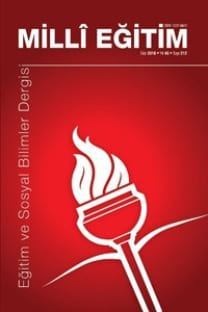COVID-19 SALGINI ZAMANINDA YABANCI DİL OLARAK İNGİLİZCE ÖĞRENEN LİSANS SEVİYESİNDEKİ TÜRK ÖĞRENCİLERİNİN ÇEVRİMİÇİ DİL DERSLERİNDEKİ AKIŞ DENEYİMLERİ
Bu çalışmanın amacı Covid-19 pandemi sürecinde lisans düzeyinde yabancı dil öğrenimi gören öğrencilerin canlı derslerde akış deneyimlerini araştırmaktır. Katılımcılar üniversite derecesinde İngiliz dili öğrenimi gören 84 öğrencidir. Veriler, çeşitleme sağlamak için Likert tipi algı ölçeği, özgeçmiş anketi ve açık uçlu sorulardan elde edilmiştir. Araştırmanın bulguları, katılımcıların farklı bileşenlerde ve seviyede akış deneyimi yaşadığını göstermiştir. Sonuçlar, akışı deneyimlemede cinsiyet bakımından anlamlı bir farklılık olmadığını da ortaya çıkarmıştır. Ayrıca, katılımcıların akış deneyimlerinin canlı ders esnasında karşılaştıkları bazı sorunlar nedeniyle kısmen sekteye uğradığı ortaya çıkmıştır.
Anahtar Kelimeler:
akış deneyimi, ideal katılım, çevrimiçi dil öğrenimi, yabancı dil öğrenimi
FLOW EXPERIENCES OF TERTIARY LEVEL TURKISH EFL STUDENTS IN ONLINE LANGUAGE CLASSES DURING COVID-19 OUTBREAK
The aim of this study is to investigate the flow experiences of foreign language (EFL) learners in online classes during Covid-19 pandemic outbreak. The participants were 84 university students as EFL learners. Data were collected by a perception survey, a background questionnaire and open-ended questions to provide triangulation. The results showed that participants had flow experiences with different levels of different categories of flow. The results also showed that there was no significant difference in terms of gender. Additionally, the findings proved that participants’ flow experiences were partially interrupted by some problems they faced during their online classes.
___
- Annamalai, N. (2019). The use of Web 2.0 technology tools and beyond in enhancing task-based language learning: a case study. English Teacher, 48(1), 29-44.
- Aşıksoy, G. (2018). ELT students’ attitudes and awareness towards the use of Web 2.0 technologies for language learning. Journal of Language and Linguistic Studies, 14(2), 240-251.
- Balçıkanlı, C. (2012). Language learning in Second Life: American and Turkish students’ experiences. Turkish Online Journal of Distance Education. 13(2), 131-146.
- Cho, M. (2018). Task complexity and modality: exploring learners’ experience from the perspective of flow. The Modern Language Journal, 102(1), 162-180, DOI: 10.1111/modl.12460.
- Cox, C. B. (2014). 21st century skills and principles of flow in the foreign language classroom. Theses and Dissertations. 4197. https://scholarsarchive.byu.edu/cgi/viewcontent.cgi?article=5196&context=etd
- Cox, C. B., & Montgomery, C. (2019). A study of 21st century skills and engagement in a university Spanish foreign language classroom. Foreign Language Annals, 52(4), 822-849.
- Csikszentmihalyi, M. (2008). Flow: The Psychology of Optimal Experience. HarperCollins
- Csikszentmihalyi, M. (1996). Creativity: Flow and the psychology of invention. HarperCollins.
- Dewaele, J. & MacIntyre, P. D. (2017). Flow in the Spanish foreign language classroom. Unpublished manuscript.
- Dickey, M. D. (2011). Murder on Grimm Isle: The impact of game narrative design in an educational game-based learning environment. British Journal of Educational Technology, 42(3), 456–469.
- Ebrahimzadeh, M. & Alavi, S. (2016). Motivating EFL students: e-learning enjoyment as a predictor of vocabulary learning through digital video games. Cogent Education, 3(1), 1-14.
- Forte, J. A., Gomes, D. A., Nogueira, C. A. & Cavaltente de Almeida, C. F. (2011). Educational services in Second Life: a study based on flow theory, International Journal of Web-Based Learning and Teaching Technologies, 6(2), 1-17, DOI: 10.4018/jwltt.2011040101.
- Fransioci, S. J. (2015). A comparison of computer game and language-learning task design using flow theory. CALL-EJ, 12(1), 11-25.
- Hong, J., Hwang, M., Tai, K. & Lin, P. (2017). Intrinsic motivation of Chinese learning in predicting online learning self-efficacy and flow experience relevant to students’ learning progress. Computer Assisted Language Learning, 30(6), 552-574, DOI: 10.1080/09588221.2017.1329215.
- Hsu, T. (2017). Learning English with augmented reality: do learning styles matter? Computers & Education, doi: 10.1016/j.compedu.2016.12.007.
- Jackson, S. A. & Marsh, H. W. (1996). Development and validation of a scale to measure optimal experience: the flow state scale. Journal of Sport & Exercise Psychology, 18, 17-35.
- Kirchhoff, C. (2013). L2 extensive reading and flow: clarifying the relationship. Reading in a Foreign Language. 25(2), 192-212.
- Lee, S. M. (2019). A systematic review of context-aware technology use in foreign language learning. Computer Assisted Language Learning, 1-25, DOI: 10.1080/09588221.2019.1688836.
- Li, R., Zhaokun, M., Tian, M., Zhang, Z. & Xiao, W. (2019). Modelling Chinese EFL learners’ flow experiences in digital game-based vocabulary learning: the roles of learner and contextual factors. Computer Assisted Language Learning, 1-25, DOI: 10.1080/09588221.2019.1619585.
- Nguyen, L. V. (2011). Learners reflections on and perceptions of computer-mediated communication in a language classroom: a Vietnamese perspective. Australasian Journal of Educational Technology. 27(8), 1413-1436.
- SimilarWeb (2020, August 20). Eba.gov.tr July 2020 overview. SimilarWeb. Retrieved from https://www.similarweb.com/website/eba.gov.tr/
- Şentürk, B. A. (2012). Teachers’ and students’ perceptions of flow in speaking activities. Uluslararası Yönetim İktisat ve İşletme Dergisi, 8(16), 283-306.
- Tashakkori, A., & Creswell, J. W. (2007). The new era of mixed methods. Journal of Mixed Methods Research, 1(1), 3-7, DOI:10.1177/2345678906293042 http://mmr.sagepub.com/content/1/1/3
- Warni, S., Aziz, T. A. & Febriawan, D. (2018). The use of technology in English as a foreign language learning outside the classroom: an insight into learner autonomy. LLT Journal: A Journal on Language and Language Teaching, 21(2), 148-156.
- ISSN: 1302-5600
- Yayın Aralığı: Yılda 4 Sayı
- Başlangıç: 1973
- Yayıncı: Milli Eğitim Bakanlığı
Sayıdaki Diğer Makaleler
PANDEMİ SÜRECİNDE K-12 DÜZEYİNDE UZAKTAN EĞİTİM: DURUM ÇALIŞMASI
İlhan ÇİÇEK, Ahmet TANHAN, Selami TANRIVERDİ
SALGIN HASTALIKLARIN CUMHURİYETTEN GÜNÜMÜZE LİSE TARİH DERS KİTAPLARINDA İŞLENİŞİNE GENEL BİR BAKIŞ
GÖÇ MAĞDURU ÇOCUKLARIN COVİD-19 SALGINI SÜRECİNDEKİ ÖĞRENME DENEYİMLERİ
Serkan ÇELİK, Nergiz KARDAŞ İŞLER
Koronavirüs (Covid-19) Küresel Salgınının Üniversite Öğrencileri Üzerindeki Etkilerinin İncelenmesi
SALGIN DÖNEMİNDE GERÇEKLEŞTİRİLEN UZAKTAN EĞİTİM SÜRECİNİN DEĞERLENDİRİLMESİ
COVİD-19 SÜRECİNDEKİ UZAKTAN EĞİTİME İLİŞKİN ÖĞRETMEN GÖRÜŞLERİNİN İNCELENMESİ
